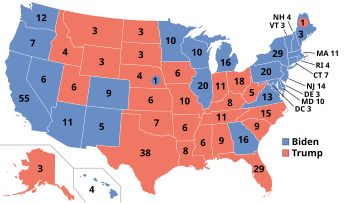User:TheSaint250/sandbox
Appearance
| ||||||||||||||||||||||||||||||||
538 members of the Electoral College 270 electoral votes needed to win | ||||||||||||||||||||||||||||||||
|---|---|---|---|---|---|---|---|---|---|---|---|---|---|---|---|---|---|---|---|---|---|---|---|---|---|---|---|---|---|---|---|---|
| Opinion polls | ||||||||||||||||||||||||||||||||
| Turnout | 66.6% | |||||||||||||||||||||||||||||||
| ||||||||||||||||||||||||||||||||
 Presidential election results map. Red denotes states won by Trump/Pence and blue denotes those won by Biden/Harris. Numbers indicate electoral votes cast by each state and the District of Columbia. | ||||||||||||||||||||||||||||||||
| ||||||||||||||||||||||||||||||||
2021 contingent U.S. presidential election | ||||||||||||||||||||||||||||||||
| ||||||||||||||||||||||||||||||||
50 state delegations of the House of Representatives 26 state votes needed to win | ||||||||||||||||||||||||||||||||
| ||||||||||||||||||||||||||||||||
House of Representatives votes by state. States and districts in red voted for Trump, states and districts in blue voted for Biden, and states in purple had split delegations. | ||||||||||||||||||||||||||||||||
- ^ "Political Parties | Northern Illinois University Digital Library". digital.lib.niu.edu. Archived from the original on May 17, 2024. Retrieved May 27, 2024.
- ^ Howe, Daniel Walker (Winter 1995). "Why Abraham Lincoln Was a Whig". Journal of the Abraham Lincoln Association. 16 (1). hdl:2027/spo.2629860.0016.105. ISSN 1945-7987.
- ^ "Historical Context: The Breakdown of the Party System | Gilder Lehrman Institute of American History". www.gilderlehrman.org. Archived from the original on May 18, 2024. Retrieved May 27, 2024.
- ^ "Major American Political Parties of the 19th Century". Norwich University Resource Library. Retrieved May 28, 2024.
- ^ McPherson, James (2003) [1988]. The Illustrated Battle Cry of Freedom: The Civil War Era. Oxford University Press. p. 129. ISBN 978-0-19-974390-2.
- ^ James M. McPherson, Ordeal by Fire: Volume I. The Coming of War, second edition (ISBN 0-07045837-5) p. 94.
- ^ Smith, Robert C. (2021). "Ronald Reagan, Donald Trump, and the Future of the Republican Party and Conservatism in America". American Political Thought. 10 (2): 283–289. doi:10.1086/713662. S2CID 233401184. Retrieved September 21, 2022.
- ^ Cite error: The named reference
Arhin-2023was invoked but never defined (see the help page). - ^ Sources for center-right:
- Gidron, Norm; Zilbatt, Daniel (2019). "Center-Right Political Parties in Advanced Democracies" (PDF). Annual Review of Political Science. 22: 18–19, 27–28. doi:10.1146/annurev-polisci-090717-092750. ISSN 1094-2939. Archived (PDF) from the original on January 23, 2023. Retrieved June 17, 2024.
- Keckler, Charles; Rozell, Mark J. (April 3, 2015). "The Libertarian Right and the Religious Right". Perspectives on Political Science. 44 (2): 92–99. doi:10.1080/10457097.2015.1011476.
To better understand the structure of cooperation and competition between these groups, we construct an anatomy of the American center-right, which identifies them as incipient factions within the conservative movement and its political instrument, the Republican Party.
- Donovan, Todd (October 2, 2019). "Authoritarian attitudes and support for radical right populists". Journal of Elections, Public Opinion & Parties. 29 (4): 448–464. doi:10.1080/17457289.2019.1666270.
A strict two-party system, such as the United States, does not fit the tripolar logic. If authoritarian attitudes exist in an electorate that effectively has no potential for anything but a choice between one centre-left and one centre-right party, people with such attitudes may find a place in one of the two dominant parties.
- Carter, Neil; Keith, Daniel; Vasilopoulou, Sofia; Sindre, Gyda M. (March 8, 2023). The Routledge Handbook of Political Parties. p. 140. doi:10.4324/9780429263859. ISBN 978-0-429-26385-9.
A primary driver of comparisons between the USA and other Anglosphere centre-right parties appears to be cultural and language affinities.
- ^ Sources for right-wing:
- McKay, David (2020), Crewe, Ivor; Sanders, David (eds.), "Facilitating Donald Trump: Populism, the Republican Party and Media Manipulation", Authoritarian Populism and Liberal Democracy, Cham: Springer International Publishing, pp. 107–121, doi:10.1007/978-3-030-17997-7_7, ISBN 978-3-030-17997-7, retrieved June 13, 2024,
the Republicans changed from being a right of centre coalition of moderates and conservatives to an unambiguously right-wing party that was hostile not only to liberal views but also to any perspective that clashed with the core views of an ideologically cohesive conservative cadre of party faithfuls
- Greenberg, David (January 27, 2021). "An Intellectual History of Trumpism". POLITICO Magazine. Archived from the original on April 11, 2024. Retrieved June 13, 2024.
The larger ideology that the president-elect represents is a post-Iraq War, post-crash, post-Barack Obama update of what used to be called paleoconservatism: On race and immigration, where the alt-right affinities are most pronounced, its populist ideas are carrying an already right-wing party even further right.
- Wineinger, Catherine; Nugent, Mary K. (January 2, 2020). "Framing Identity Politics: Right-Wing Women as Strategic Party Actors in the UK and US". Journal of Women, Politics & Policy. 41 (1): 5. doi:10.1080/1554477X.2020.1698214. ISSN 1554-477X.
- Jessoula, Matteo; Natili, Marcello; Pavolini, Emmanuele (August 8, 2022). "'Exclusionary welfarism': a new programmatic agenda for populist right-wing parties?". Contemporary Politics. 28 (4): 447–449. doi:10.1080/13569775.2021.2011644. ISSN 1356-9775.
- McKay, David (2020), Crewe, Ivor; Sanders, David (eds.), "Facilitating Donald Trump: Populism, the Republican Party and Media Manipulation", Authoritarian Populism and Liberal Democracy, Cham: Springer International Publishing, pp. 107–121, doi:10.1007/978-3-030-17997-7_7, ISBN 978-3-030-17997-7, retrieved June 13, 2024,





